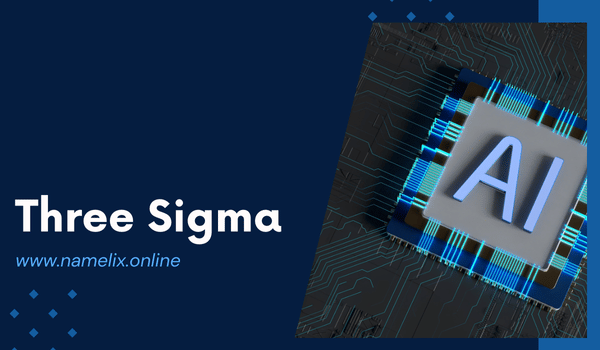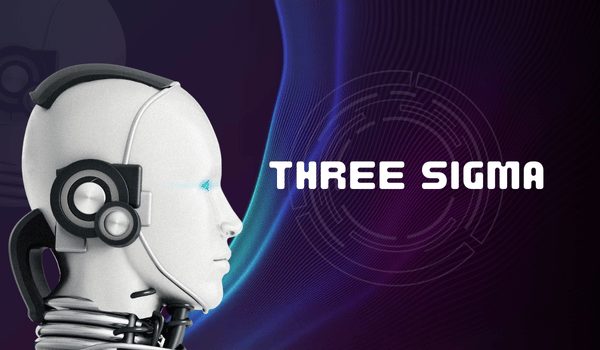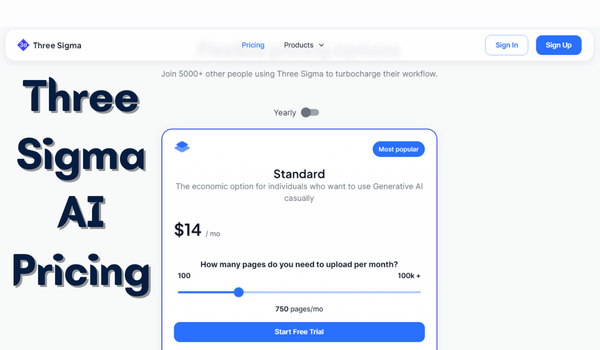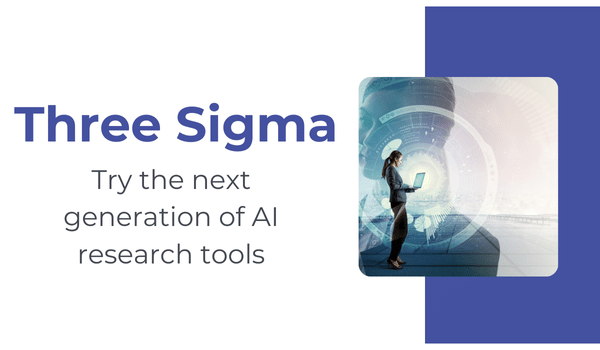Dive into the future of research with Three Sigma AI, the game-changing tool that’s revolutionizing data analysis. In today’s fast-paced digital world, this AI-powered platform is your key to staying ahead.
Imagine having a brilliant research assistant available 24/7. That’s Three Sigma AI. Whether you’re a student, professional analyst, or curious mind, this tool is designed to supercharge your research process.
Three Sigma AI isn’t just another gadget. It’s a comprehensive research companion that uses advanced AI to streamline your work. From sorting through vast amounts of data to generating insightful reports, it’s built to make your research more efficient and effective.
But what exactly can Three Sigma AI do for you? How does it work its magic? And how can it transform your approach to information gathering?
In this article, we’ll explore the world of Three Sigma AI. We’ll uncover its powerful features, discuss its potential limitations, and show you how to harness its capabilities to elevate your research game.
Whether you’re aiming to boost productivity, enhance data analysis, or simply stay ahead of the curve, It might be the secret weapon you’ve been searching for. Let’s unlock the power of AI-driven research together.

What is Three Sigma AI?
Understanding the Basics
Three Sigma AI is a cutting-edge artificial intelligence platform designed to assist with research and data analysis. It’s named after the statistical concept of “three sigma,” which refers to data within three standard deviations of the mean. This name hints at the tool’s focus on precision and accuracy in data handling.
The Purpose of Three Sigma AI
The main goal of Three Sigma AI is to simplify complex research tasks. It does this by automating many of the time-consuming processes involved in data collection, analysis, and interpretation. With Three Sigma AI, users can quickly sift through vast amounts of information and extract meaningful insights.
Who Can Benefit from Three Sigma AI?
Three Sigma AI caters to a wide range of users. These include:
- Researchers in various fields
- Data analysts
- Students working on academic projects
- Businesses seeking market insights
- Journalists fact-checking information
Key Capabilities
Some of the key things Three Sigma AI can do include:
- Searching and summarizing academic papers
- Analyzing large datasets
- Generating reports and visualizations
- Fact-checking and cross-referencing information
- Providing real-time answers to research questions
By offering these capabilities, Three Sigma AI aims to make research more efficient and accessible to everyone. It’s not just about saving time; it’s about enhancing the quality and depth of research across various fields.
How do you use Three Sigma AI?
Getting Started
Using Three Sigma AI is straightforward. Here’s a basic guide to help you get started:
- Sign up for an account on the official website.
- Choose a plan that fits your needs.
- Log in to your account.
- Set up your research preferences.
- Start using the tool for your research tasks.
Basic Functions

Searching for Information
To search for information:
- Type your query into the search bar.
- Use filters to narrow down your results.
- Click on relevant results to view more details.
Analyzing Data
For data analysis:
- Upload your dataset to the platform.
- Choose the type of analysis you want to perform.
- Let Three Sigma AI process the data.
- Review the results and insights provided.
Generating Reports
To create reports:
- Select the ‘Generate Report’ option.
- Choose the type of report you need.
- Input the necessary information.
- Let Three Sigma AI compile the report for you.
Advanced Features
Custom Queries
For more specific research:
- Use the custom query builder.
- Input your specific parameters.
- Let Three Sigma AI fetch tailored results.
Collaboration Tools
To work with others:
- Invite team members to your project.
- Share your research findings.
- Collaborate in real-time on the platform.
Remember, the more you use Three Sigma AI, the better you’ll become at leveraging its features. Don’t be afraid to explore and experiment with different functions to find what works best for your research needs.
How Three Sigma AI Works
The Technology Behind Three Sigma AI
Three Sigma AI uses advanced machine learning algorithms and natural language processing (NLP) to power its functions. These technologies allow the tool to understand and process human language, making it easier for users to interact with the platform.

Data Sources
It pulls information from a wide range of sources. These include:
- Academic databases
- News outlets
- Government reports
- Social media platforms
- Public datasets
The tool constantly updates its database to ensure users have access to the most recent and relevant information.
Processing and Analysis
When you input a query or upload data, Three Sigma AI goes through several steps:
- It first understands your request using NLP.
- Then, it searches its vast database for relevant information.
- Next, it analyzes the data using various statistical and machine-learning models.
- Finally, it presents the results in an easy-to-understand format.
Continuous Learning
One of the key features of it is its ability to learn and improve over time. As more users interact with the platform, it becomes smarter and more efficient. This means that the quality of results and analysis improves with each use.
By leveraging these advanced technologies, It aims to provide users with a powerful yet user-friendly research tool. It’s designed to handle complex tasks while presenting results in a way that’s easy for anyone to understand and use.
Key Features of Three Sigma AI
1. Smart Search
Three Sigma AI’s smart search function goes beyond simple keyword matching. It understands context and intent, providing more relevant results. Features include:
- Semantic search capabilities
- Auto-suggestion for search terms
- Filters for refining search results
2. Data Analysis Tools
The platform offers a range of data analysis tools, including:
- Statistical analysis
- Trend identification
- Predictive modeling
- Correlation analysis
These tools help users extract meaningful insights from complex datasets.
3. Natural Language Processing
Three Sigma AI’s NLP capabilities allow it to:
- Understand and respond to queries in natural language
- Summarize long texts
- Extract key information from documents
This makes it easier for users to interact with the platform and quickly find the information they need.
4. Visualization Tools
To help users better understand data, Three Sigma AI offers:
- Interactive charts and graphs
- Custom visualization options
- Real-time data visualization
These tools make it easier to spot trends and patterns in data.
5. Collaboration Features
Three Sigma AI supports teamwork with:
- Shared workspaces
- Real-time collaboration tools
- Version control for research projects
These features make it easier for teams to work together on research projects.
6. Customization Options
Users can tailor Three Sigma AI to their needs with:
- Customizable dashboards
- Personalized alert settings
- Saved searches and preferences
This allows each user to create a research environment that works best for them.
7. Integration Capabilities
Three Sigma AI can integrate with other tools and platforms, including:
- Citation management software
- Cloud storage services
- Project management tools
This allows for a seamless workflow across different applications.
By offering these key features, Three Sigma AI aims to provide a comprehensive research solution that caters to a wide range of needs and preferences.
Three Sigma AI Pricing

Pricing Plans
Three Sigma AI offers several pricing tiers to suit different needs and budgets:
Basic Plan:
- Ideal for individual researchers or students
- Limited searches per month
- Basic analysis tools
- No collaboration features
Pro Plan:
- Suitable for professional researchers or small teams
- Unlimited searches
- Advanced analysis tools
- Basic collaboration features
Enterprise Plan:
- Designed for large organizations or research institutions
- Unlimited everything
- Full suite of analysis tools
- Advanced collaboration features
- Dedicated support
Free Trial
Three Sigma AI offers a free trial period. This allows users to test the platform before committing to a paid plan. The trial typically includes:
- Limited access to features
- A set number of searches
- Basic analysis tools
Payment Options
Users can pay for Three Sigma AI through various methods:
- Credit/Debit cards
- PayPal
- Bank transfers (for Enterprise plans)
Billing Cycles
Three Sigma AI offers flexible billing options:
- Monthly billing
- Annual billing (often at a discounted rate)
- Custom billing cycles for Enterprise clients
Remember to check the official website for the most up-to-date pricing information. Prices and plans may change over time as the platform evolves and adds new features.
Limitations Of Three Sigma AI
While Three Sigma AI is a powerful tool, it’s important to be aware of its limitations:
- Data Dependence: The quality of results depends on the data available. In some niche areas, data might be limited.
- Learning Curve: Despite its user-friendly design, some users might need time to fully utilize all features.
- Internet Requirement: Three Sigma AI needs a stable internet connection to function properly.
- Language Limitations: While it supports multiple languages, coverage might not be equal for all.
- Ethical Considerations: As with any AI tool, there are potential biases in data and algorithms to be aware of.
- Cost: Higher-tier plans might be expensive for individual users or small organizations.
- Updates: Frequent updates might temporarily disrupt workflow as users adapt to new features.
Understanding these limitations can help users set realistic expectations and make the most of Three Sigma AI’s capabilities.
Pros and cons
Pros:
- Advanced AI-powered research capabilities
- User-friendly interface
- Comprehensive data analysis tools
- Collaboration features for team projects
- Customizable to suit individual needs
- Regular updates and improvements
- Integration with other tools and platforms
Cons:
- Potential learning curve for new users
- Higher-tier plans can be expensive
- Requires stable internet connection
- May have limitations in very niche research areas
- Possible over-reliance on AI for research tasks
- Privacy concerns with data handling
- May not fully replace traditional research methods
Three Sigma AI Login and Sign Up
Here’s a step-by-step guide to sign up and log in to Three Sigma AI:

Sign Up:
- Go to the Three Sigma AI website
- Click on the “Sign Up” or “Get Started” button
- Enter your email address
- Choose a strong password
- Select your preferred plan
- Enter payment details (if choosing a paid plan)
- Click “Create Account”
- Verify your email address by clicking the link sent to you
Login:
- Visit the Three Sigma AI website
- Click on the “Login” button
- Enter your email address
- Type in your password
- Click “Login”
- If you’ve forgotten your password, click “Forgot Password” and follow the reset instructions
Remember to keep your login details secure. It’s a good idea to use a unique, strong password for your Three Sigma AI account.
What Makes Three Sigma AI Unique?
Three Sigma AI stands out in several ways:
- Advanced AI: It uses cutting-edge AI technology for more accurate and insightful research.
- User-Friendly: Despite its complex functions, it’s designed to be easy to use.
- Comprehensive Tool: It offers a wide range of features in one platform, from data analysis to report generation.
- Adaptability: It can be used across various fields, from academic research to business intelligence.
- Continuous Learning: The AI improves over time, offering better results as more people use it.
- Collaboration Focus: Its team features make it ideal for group projects and organizational use.
- Customization: Users can tailor the tool to their specific needs and preferences.
These unique features make Three Sigma AI a versatile and powerful tool for modern research needs.
Alternatives for Three Sigma AI
- ChatPDF – This AI tool allows you to have a conversation-like experience with your PDFs,pen_spark asking questions and getting answers directly from the document.
- Socratic.org – This AI-powered learning platform helps you gain a deeper understanding of complex topics by facilitating a question-and-answer dialogue.
- Scilit – Specializes in scientific research, Scilit uses AI to help you find relevant research papers, analyze data, and even generate citations.
- Lexalytics Semantapsis – Leverages advanced natural language processing (NLP) to uncover hidden insights from large amounts of textual data.
- OpenAI API – This open-access platform provides various AI tools and functionalities, including text generation, translation, and code completion. While it requires more technical expertise to use, it offers a wide range of capabilities for developers and researchers.
- ResearchBuddy AI: ResearchBuddy uses AI to automate literature reviews, saving researchers time by finding key info in uploaded papers.

FAQs
While Three Sigma AI is versatile, it’s best suited for data-driven research across various fields. It may be less effective for highly specialized or qualitative research that requires human interpretation.
No, Three Sigma AI is designed to assist and enhance human research, not replace it. It’s a tool to make research more efficient, but critical thinking and interpretation still require human expertise.
Three Sigma AI takes data security seriously, using encryption and following best practices. However, users should always be cautious about uploading sensitive information to any online platform.
Yes, Three Sigma AI supports multiple languages, but the extent of support may vary. English typically has the most comprehensive coverage.
Three Sigma AI offers integration capabilities with various tools and platforms. Check their documentation or contact their support team for specific integration options.
Conclusion
Three Sigma AI represents a significant leap forward in AI-powered research tools. It offers a comprehensive suite of features designed to streamline and enhance the research process. From smart searches to advanced data analysis, it provides valuable assistance to researchers across various fields.
While it has its limitations and may not be suitable for every type of research, Three Sigma AI’s unique capabilities make it a powerful ally for many. As with any tool, its effectiveness largely depends on how it’s used. When leveraged properly, Three Sigma AI can significantly boost research productivity and quality.
As AI technology continues to evolve, tools like Three Sigma AI will likely become increasingly sophisticated and indispensable in the world of research. Whether you’re a student, professional researcher, or data enthusiast, it’s worth exploring what Three Sigma AI can do for you.
